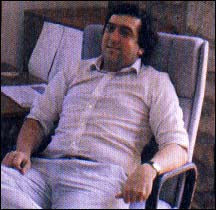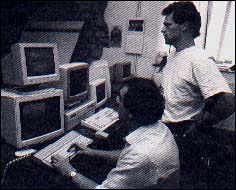The TRANSPUTER CONNECTION
Atari and Perihelion
An Exclusive Interview with Perihelion's Dr. Tim King
BY MARSHAL M. ROSENTHAL
 |
| Dr. Tim King, president of Perihelion Software Ltd., is the creator of the Helios operating system for the Atari Transputer Workstation. He's also well- known for his work on ST BASIC and the AmigaDOS operating system. |
For two years now, Atari has been showing of its high-end transputer-based workstation. Now, as the ATW nears its US. release, START presents an exclusive interview with Dr. Tim King, president of Perihelion Software Ltd. and the creator of the ATW's operating system.
Three hours from London, England, in the township of Bath, is the home of Atari's Transputer Work Station (ATW), Perihelion Ltd. Dr. Tim King, the president of Perihelion, is as warm and friendly as the unusually sunny British summer afternoon on which we interviewed him. A talented programmer and designer, he is best known as the creative force behind ST BASIC and Amiga DOS for Metacomco. King's latest achievement is Helios, the Unix-like operating system mated to the Metacomco-designed ATW. But just what kind of computer is the ATW?
"A Transputer is an entire computer on a chip-running at 20 nanoseconds," explains King. "Trying to achieve greater speed in computing never seems to end--we keep trying to get closer to the speed of light. This results in more powerful computer systems running at greater speed. But the Transputer's extreme speed comes from its new and unique system. It's the way it processes information that's astounding. Let me show you what I mean." King leaps up from his desk, grabs a pen and starts scribbling on a wall board. "I always enjoy lecturing, you know," he says.
"Let's say you have 10 tasks to perform, X1 through X10," he begins. "The normal computer will take the first task, finish it and then start on the second. This goes on until the tenth task has been completed, the computer being 'locked' into handling this process from start to finish. It's a little like being forced to draw 10 buckets of water from a well, one by one until you're done. But the Transputer doesn't have to put up with that because it can do parallel processing. What happens here is that we're using multiple computers, each handling a single task. This means that X1 is being worked on at the same time as X10. So all the buckets are being drawn simultaneously--the results being accomplished blindingly fast because it's all being done at the same exact time.This just wasn't possible before."
The Tortoise and the Hare
As an example King offers a procedure that takes a 25mHz 80386 machine 3 1/2 hours to perform. "Figure nine seconds for the ATW," he grins. "And don't confuse it with multitasking, because there you have one processor dividing its time between a number of tasks."
"Let's consider just what we have here," he says. "The Transputer is a RISC [Reduced Instruction Set Chip] operating at 50mHz and contains a floating-point arithmetic logic unit. There's 4K of RAM on the chip as well. The ATW accesses a 32-bit bus, has a special "Blossom" blitter chip and uses four megabytes of RAM, upgradable to 120 meg. There are also slots to accommodate special boards. It's a totally unique configuration that includes four operating communication engines, with the serial COM running at 20 megabits per second and video RAM taking up one megabyte.
"The ATW is linked to the 68000 microprocessor, so it doesn't have to be concerned with such chores as disk control, mouse or keyboard. This is all taken care of at the 68000 end, leaving the Transputer free to handle the heavy stuff." King points to the open guts of an ATW nearby. "Here's where it gets amazing," he says, pointing to the open slots inside the unit. "You can add processing boards with more Transputers for increased power. Each of these daughter boards has three Transputers on it, and the ATW can hold a total of four boards which means 13 Transputers, all working at once at 10 MIPS [Million Instructions Per Second] and using some 16 megabytes of RAM. That gives you a total of one-fifth the power of a Cray supercomputer"
 |
The ATW fea- tures a graphical interface not unlike the ST's, but each window has its own dy- namic color map and its own pal- ette. |
Unix Plus
Lecture completed, King walks out of the office and over to one of the ATWs in the adjacent work area. "Our Helios operating system took two years to develop and is Unix-like," he says, "being command-line driven and having a mouse/graphical interface. It's highly compatible between computer systems, mainframes and Work Stations."
King inserts a 3 1/2-inch disk and boots up the machine. The graphical Desktop appears, and for a moment it looks like a typical ST screen. But that illusion quickly dies as King brings up windows that appear with violent speed on screen--each window having its own dynamic color map and distinct palette. "Notice that you can move windows under each other as well as around," King says. "Plus you can see that the background can contain patterns-like the little 'Helios' wallpaper now up." King also calls to our attention that what we're looking at [on an analog RGB monitor costing some 2,000 pounds is a 1,280-by-1,024-pixel display in 16 colors; the famous Baboon face graphic never looked this good before. The other resolutions available through this system include 1,024-by-768 with 256 colors, and 16 million colors on a 512-by-512 screen.
"How about a real test of power?" King says mischievously. He brings up the Mandelbrot set, a mathematical model that graphically demonstrates a computer's processing speed. "We're going to do a nice one now that shouldn't take more than a day or so." King activates the program and all the Red LEDs in the ATW's processing boards light up, indicating that they're online. We don't wait a day, or an hour or even a minute. The image appears on screen in just under 27 seconds.
The Price of Power
We wonder what such computing power must cost--after all, a Cray costs millions of dollars. "Considering what you're getting, it's not bad at all," says King. He informs us that the basic ATW costs £5,000 (about $8,000)--with each daughter board being £3,000 (about $5,000). The system that ran the Mandelbrot would cost nearly $80,000. King also notes that while the ATW is currently available in Europe, though in a heavily backordered state, Atari's marketing plans for the ATW in the States are not known at this time. (Editor's Note: Atari has announced plans to release the ATW in the U.S. in the fourth quarter of 1989.)
 |
Perihelion presi- dent Dr. Tim King at the keyboard of Atari's top- end graphics workstation, the ATW. |
But the ATW's future applications are what interest us now. A flight simulator would be astounding on the ATW, even without any sound output. King mentions that one of the uses for high-speed workstations is in the medical field. "There are scanners that cover the entire human body a 'slice' at a time, then assemble it all as a 3D image that the physician can rotate and look at. But this takes time. With the ATW, you could do a scan and watch the body image breathing, because it would be in real time."
King's affection and admiration for the ATW is infectious. "I applaud Atari for having the vision to head into the next generation of computing power," he says. "Even though the 68000 is being put to good use, it's too commonplace now, quite old and a bit boring. The ATW represents a completely new and unique machine--one that pushes the limits farther than ever before--and one that will make its mark felt."
Marshal M. Rosenthal is an international writer and photographer whose work can be found in major publications in Europe and the United States. He lives in New York City.